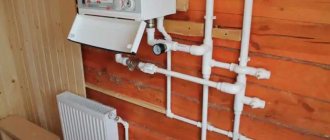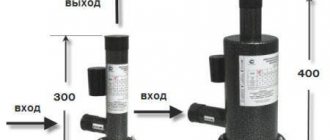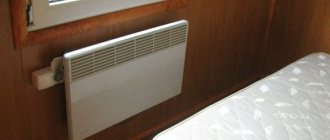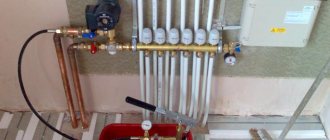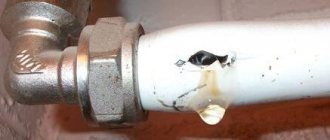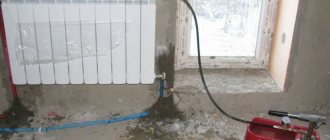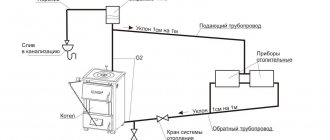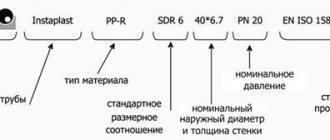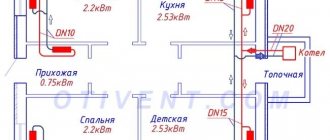Residents of apartments who have decided to abandon central heating, as well as owners of private houses, have plenty to choose from. For autonomous heating, gas and electric systems are used - boilers, heated floors, infrared and oil heaters, convectors. In medium-sized or large-sized rooms, it is advisable to install boilers that run on electricity or gas. Let's look at the first type of heaters, the features of their installation in an apartment, the rules of choice, as well as all the pros and cons that electric boilers have.
How to abandon central heating and switch to individual heating is written here.
Why is an electric heating boiler better than a gas one?
Despite the fact that gas is a cheaper source of energy than electricity, installing gas equipment is not always preferable. The main obstacles to installing a boiler of this type are:
- Difficulties with obtaining permission, coordination and preparation for installation. The room must have a properly organized ventilation system and removal of combustion products.
- High cost of equipment and labor intensive installation. And if we are talking about a private house where gas is not supplied, then the costs increase significantly.
- Potential danger of the fuel itself and its combustion products.
Advantages of electric heating systems
Electric boilers have many advantages, including:
- High reliability in terms of fire safety (of course, subject to the availability of high-quality wiring and fuses).
- Low installation costs, easy installation.
- Wide price range, choice of functions. In general, electric models are cheaper than gas models. You can choose a simple boiler, consisting of a set of heating elements and a primitive control system, which will cost very little. If there are no financial restrictions, you should pay attention to automated devices. They are able to maintain a given temperature with minimal energy consumption and have several programming modes, a GSM controller that allows you to regulate the operation of the device from a distance, and other useful options.
- Compact and aesthetically pleasing. In many modern models, all the necessary elements - a circulation pump, an expansion tank, an air vent, protection systems - are hidden inside the housing. If desired, the electric boiler can be installed in any room of the apartment. The most common are wall-mounted varieties.
- Ease of use. To control the device you only need to press a few buttons. Electric boilers do not require control or participation in their operation.
- Silence. The owners can only hear the quiet hum of the induction device or the hum of the automation units.
- There is no need for coordination with relevant organizations when the device power does not exceed 9 kilowatts.
- High efficiency.
Disadvantages and difficulties of operating electric boilers
The advantages of electric boilers look attractive. But they also have disadvantages, and very significant ones.
- High cost of electricity.
Note! Costs can be reduced several times by insulating the apartment, using preferential electricity tariffs and choosing a device with precise adjustment.
- Requirements for the type of radiators. In an electrically heated system, it is uneconomical to use cast iron and steel batteries. It is advisable to choose bimetallic or, as a last resort, aluminum heating devices.
- Complete dependence on power supply.
- Demanding on the quality and composition of the coolant.
- When installing equipment that consumes more than 9 kW, instead of a standard 220 V network, a three-phase 380 V network will be required. If the apartment does not have one, you must obtain special permission for the installation, which is not always possible in old houses.
USEFUL INFORMATION: Heated towel rails in the bathroom interior (photo)
Before you decide to purchase and install an electric boiler, you need to weigh all the pros and cons, calculate the approximate electricity consumption per month and think about how significant it will be for the budget.
Electric heating in the apartment
One of the most comfortable types of heating is electric heating; it is reliable and environmentally friendly for heating a home, even if you installed it yourself. It does not produce harmful emissions, is easily regulated and automated. Due to electricity prices, this is not the most popular heating option. But people living in high-rise buildings have another problem - the consumption limit is only 3-5 kW.
Note. Find out in advance what the electricity limit is and whether it is generally allowed to use electric heaters.
You have a choice of which electric heating system to use. We've ranked them from least to most expensive to install and purchase.
- Fan heaters and convectors.
- Electric baseboard heaters.
- Infrared heating.
- Cable heated floors and film.
- Water system with radiators and electric boiler.
In a small apartment, cable heated floors would be a good option; they cannot be compared in terms of comfort. It's cheap, but in severe frost the temperature in the building will be low.
If the room is large in area, then radiator autonomous electric heating or the second option, water heated flooring, will come in handy.
If you still have old cast iron batteries in your home, they can be used as autonomous water heaters. To do this, it is necessary to install a low-power heating element in each battery. In the video you will see how to connect heating elements to the electricity network through thermostats.
Electric boilers with heating elements (tubular heaters)
Such boilers work on the same principle as most household electrical appliances - kettles, boilers, irons. They are most in demand among consumers and are presented in a wide variety of models. There can be several heating elements, and they are turned on together or alternately.
Pros:
- simplicity of design;
- reliability of the circuit, ease of repair.
Minuses:
- high inertia of boilers - slow heating at startup;
- demands on the quality of the coolant. The tendency for scale to form, which reduces heating efficiency, forces special measures to be taken. You can install anode rods that will collect salt deposits on themselves, and change them at certain intervals, just like the heating elements themselves. But it is better to use specially prepared water or a special coolant.
Induction devices
Induction boilers are energy-efficient and reliable devices that can operate for years without maintenance or repair.
Pros:
- thanks to the phenomenon of self-induction, they significantly save energy (up to 30% during the heating season);
- undemanding to the composition of the coolant (scale does not appear in such boilers);
- service life - from 30 years, the likelihood of breakdown due to the design features is very low;
- quick heating of the coolant;
- possibility of precise adjustment.
Minuses:
- large mass (from 30 kg) - strong brackets are used for hanging, the wall must be able to withstand the load;
- circulation pump, expansion tank, safety group are purchased and installed separately;
- relatively high cost;
- vibration noise during operation.
Ionic (electrode) heating boilers
Such devices heat the coolant by applying voltage through the electrodes, resulting in the ionization of molecules and their movement towards a conductor with a different polarity. In a single-phase network, one electrode is used in the form of a rod, the second is the surface of a metal cylinder, with three-phase voltage - 3 electrodes.
USEFUL INFORMATION: Warm floors under tiles: which is better, reviews
The sizes of ion boilers vary from very small ones, capable of heating only one battery, to large installations designed for a large house. Available both with and without casing.
Pros:
- compactness. The device without a housing takes up little space;
- high-speed heating of the coolant;
- low inertia, allowing very precise adjustment;
- resistance to voltage surges;
- high level of safety - if there is no coolant in the boiler, it simply cannot work;
- low price (without control unit, pump and expansion tank).
Minuses:
- complete incompatibility with batteries made of steel and cast iron;
- demands on the quality of the circulating fluid, which must have a balanced composition. It is recommended not to make it yourself, but to purchase a ready-made one;
- the need for a specialist to check the condition of the coolant before the new heating season;
- special requirements for the grounding loop;
- heating temperature – no higher than 75 °C;
- the need to replace electrodes at certain intervals.
Seven ways to organize inexpensive heating of a private home with electricity
Electric convector
The operating principle of convectors is to circulate air through heating elements. According to the laws of physics, warmer air rises and mixes with colder air. This way the room is heated evenly.
The advantages of such devices are heating speed and efficiency of 80%, compact size with high power. In addition, a variety of operating modes and a built-in thermostat allow you to efficiently use electricity only when the ambient temperature drops.
We should also highlight the mobility that a convector heater has. By moving it to the coldest areas of the room, you can quickly and evenly heat the entire space.
A big plus for convectors is permission for use in wet rooms. Water protection allows you to install such an electrical appliance even in a bathroom or toilet.
Like any household appliance, in addition to significant advantages, convector heating also has disadvantages: connecting all devices to the network immediately entails exceeding the permitted power.
THIS IS IMPORTANT: When installing a relay that regulates the sequential start of heaters, the possibility of exceeding the permitted power is eliminated. This solution will maintain a comfortable temperature in a private home and reduce costs.
Tubular electric heater
The principle of operation of the system is to transfer heat from the heater to the coolant liquid in the pipes. Traditionally, the coolant is water, oil or antifreeze. In simple words, this is a device that works by analogy with an electric kettle or boiler. Heating element immersed in liquid. When used to organize economical electric heating of a private home, such devices show high efficiency and minimal heat loss.
Tubular electric heaters are often called oil radiators or heaters. In times of shortage, such devices were even made by hand. Photos and videos of homemade radiators can be found on construction forums.
The main advantages of tubular type heaters are their reliability. They are not explosive and are not afraid of external influences such as vibration and shock. In addition, their design is so diverse that it allows the device to harmoniously fit into any interior.
Tubular electric batteries have one significant drawback - high price. The point is the high cost of the metal from which heating heating elements are made.
THIS IS IMPORTANT: The “filling” of the radiator matters. Carbon steel tubes are only suitable for medium and sometimes high temperature applications. To maintain constant high or critical temperatures, choose tubes made of stainless steel.
Electric heated floor
A modern way to heat large areas without using radiators. The easiest to install underfloor heating is available in the form of ready-made heating mats, which must be distributed over the surface, connected and hidden under a layer of screed. Heated floors have a big advantage - due to the fact that the heat in the room is distributed evenly, the number of dust particles in the space of the house is reduced.
Electric boiler with heating element
The growing popularity of such boilers lies in their high reliability, safety and relatively low price, especially in comparison with induction or electrode boilers. However, such a heating system cannot be called “The best electric heating” and it cannot be called cheap either. Boilers of this type use thermoelectric heaters - not the most economical devices in terms of power consumption.
THIS IS IMPORTANT: Before installing a boiler with a heating element, check with the electrical network company about the maximum possible load on the wiring in your home.
Induction electric boiler
A two-winding transformer is hidden inside the device. Eddy currents arising in it move behind a short-circuited loop, which is the body of the induction boiler. At this moment, the secondary winding receives a certain amount of energy and converts it into heat, which warms up the coolant liquid.
Induction boilers are characterized by 100% efficiency, resistance to voltage surges, rapid space heating and durability. They simply don't contain parts that could break!
Electrode heating boilers
The operating principle of heating devices of this type is as follows: the role of heating elements in it is performed by electrodes. They are immersed in a coolant liquid. As electric current passes through the electrodes, heat is released. Thus, scale does not form inside the boiler, which greatly simplifies its use at home.
In addition to the absence of scale, the electrode boiler lasts much longer than a tubular heater and has a compact size, which is suitable for use in a small home.
Uninterrupted operation of the device is only possible if the correct liquid is poured into the electric boiler. If it is water, then after multi-stage filtration, if it is antifreeze, then only of the brand of the same name as the boiler.
Single-circuit and double-circuit boilers: what is the difference?
Let's look at the differences between the two modifications of these units.
- Single-circuit boilers are designed only for heating the room. At the same time, an indirect heating boiler can be connected to all modern boilers and hot water supply can be provided.
- Double-circuit, in addition to participating in the heating system, heat water for domestic needs. Their design provides an additional heat exchanger, which can be flow-through or storage - in the form of a built-in water heating tank.
Note! A double-circuit boiler cannot operate on 2 circuits at the same time. When you open a hot water tap, heating of the heating fluid stops.
Let us briefly describe their advantages and disadvantages.
Advantages of a single-circuit boiler:
- relatively low cost;
- high efficiency and high power;
- lower energy consumption (no boiler).
Minuses:
- if necessary, you will have to install an additional boiler to heat water;
- together with an indirect heating boiler, the design looks bulky and unaesthetic.
Advantages of a dual-circuit device:
- quite compact size;
- easy installation.
Minuses:
- instability of water pressure and temperature;
- high requirements for coolant quality and maintenance;
- high cost.
Note! If we compare the prices of a double-circuit boiler and a device with one circuit and an additional boiler, the first will cost less.
It's difficult to say which boiler is better. If it is important to save energy, as well as space in the apartment, you should choose a double-circuit version. This device heats water only when it is needed; the single-circuit device will turn on every time the liquid cools down. At the same time, a single-circuit boiler is considered more reliable and convenient to use.
Advice. If your automated boiler has an additional storage tank, it can be programmed to heat water at night when electricity rates are lower. During the day, when the cost of electricity is higher, you can use already heated water.
How to save on electricity in an apartment?
If you don’t know how to make electric heating in an apartment cheap, then you need to read our article. When installing heating it is necessary to use thermostats. Temperature regulators allow you to save a lot of money. Temperature regulators allow you to set the optimal temperature.
Another advantage is the installation of a multi-tariff meter. The benefit after its installation will depend only on the region. Those who have these meters use the heating system only at night. This way you can save half of your electricity.
The last way to save money is to insulate rooms. If you perform high-quality thermal insulation, then the power of the heaters can be saved by 40%. Now you know how to make your own individual heating of an apartment with electricity in an apartment building.
Read: installing a convector with your own hands.
Power
The power of the boiler is its most important characteristic, which means you need to choose it correctly. Sometimes it is tied to the footage and calculated based on the value of 1 kW per 10 m2. This formula is only suitable for a very rough estimate.
USEFUL INFORMATION: Choosing ceramic tiles for the bathroom
In fact, you need to focus on heat loss. If, for example, they are 8 kW, then you need a boiler of the same power. The calculations take into account:
- area and height of the room;
- degree of insulation of walls, floors, ceilings;
- the number of external walls and their location according to the cardinal directions;
- number, dimensions and type of windows;
- battery connection diagram;
- region of residence and other parameters.
To correctly calculate the boiler power, it is recommended to use special calculators or seek advice from a heating engineer.
Heating scheme
In centralized heat supply, a single-pipe scheme is used, which is inferior in efficiency to a two-pipe scheme. The single-pipe system is used only for a small number of radiators in situations where savings are needed.
The optimal choice for individual heating is a two-pipe scheme. It has the following advantages:
- use of pipes and fittings of smaller diameter;
- high pressure stability in the system;
- the possibility of installing automatic flow regulators on all batteries, which will operate without compromising the heating of other radiators;
- independent connection of each heating section, allowing it to be removed for maintenance or gaining access to the niche during repairs.
USEFUL INFORMATION: How to overcome noise in radiators?
Additional functions
The following functions of electric boilers may be useful:
- protection systems – from overheating, short circuit, overpressure;
- the ability to install a GSM controller, which will allow you to remotely adjust the temperature in the apartment, change the boiler settings, and send notifications about possible problems;
- a control unit with energy-saving modes that allow you to reduce the temperature at certain periods of time - at night, when residents are not at home;
- smooth power adjustment. This option is more convenient and profitable than the stepped one.
Note! Often control units are not included in the package of electric boilers. In this case, they will have to be purchased separately.
What is autonomous heating?
The transition to individual heating of an apartment involves abandoning the use of a common building heating system and dismantling the radiators and pipes associated with it. Instead, new lines and batteries are installed, which are connected to the heater. Two types of installations are traditionally used in apartments - gas and electric boilers. The principle of operation of the device is simple: it increases the temperature of the water and forces it to circulate through the system, heating the room in the desired mode.
USEFUL INFORMATION: How to install a temperature controller on a battery
Popular models
Among the variety of brands, the leading positions in the ranking are occupied by the following manufacturers:
- Protherm (Slovakia),
- Vaillant (Germany),
- Kospel (Poland),
- Buderus (Germany).
Among Russian brands, buyers give preference to 4 brands, including:
- "TEPLODAR"
- "EVAN"
- ZOTA,
- "RusNIT".
The best models from the category of medium-power boilers that are suitable for apartments, based on user reviews:
- Teplodar Sputnik 6 (8.1 thousand rubles);
- RusNit 208M (average price - 16 thousand rubles);
- EVAN Warmos-IV-5 (16.5 thousand rubles);
- ZOTA 12 Lux (RUB 21.4 thousand);
- Kospel EKCO L2 12 (37 thousand rubles);
- Protherm Skat 12 KR 13 (32.5 thousand rubles);
- Vaillant eloBLOCK VE 12 (35 thousand rubles);
- Buderus Logamax E213-10 (9.3 thousand rubles).
Teplodar Sputnik 6 in black
Teplodar Sputnik 6 in white
